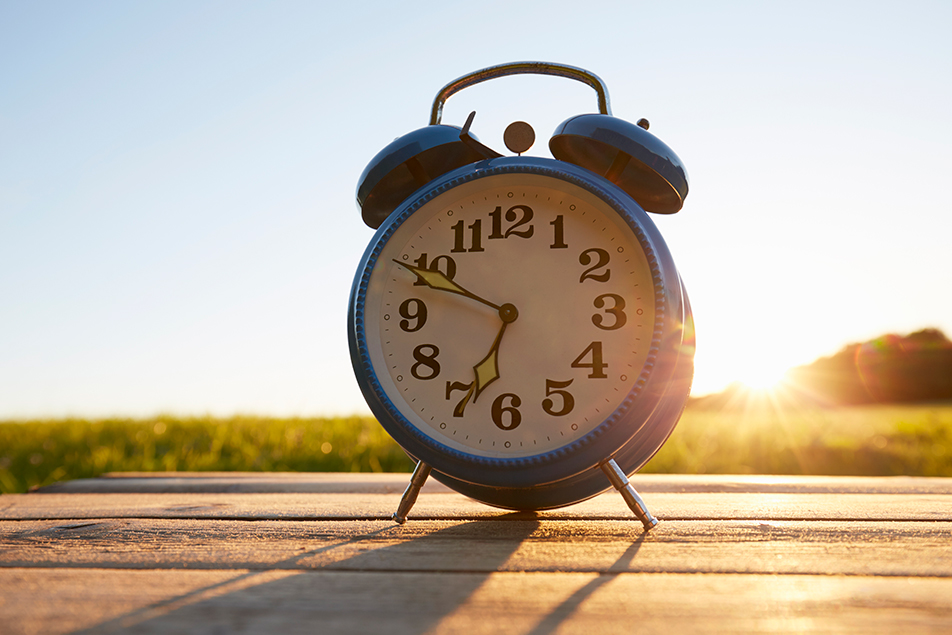
This weekend we’ll change the clocks and readjust to the cadence of our sunrises and sunsets. While many find the transition beneficial, it has its drawbacks. Aaron Roberts, MD, PPG – Sleep Medicine, explains the effects of Daylight Saving Time (DST) when it comes to our sweet, restorative sleep.
Most Americans do not get the recommended 7-9 hours of sleep per night as is, so losing another hour is like pouring salt into a wound. Over the years, many studies have been done to look at the effects of DST on our health with mixed results. But as time goes on, and more research is done, evidence is mounting against its routine use due to all the negative health consequences.
The history of DST.
DST was first put to the test in 1918, during World War I, as a wartime measure to save on energy. It was later implemented numerous decades later via the Uniform Time Act of 1966 to increase the opportunity to spend time outdoors and decrease energy expenditure. In most of the United States (apart from Arizona, Hawaii, and the U.S. territories), DST starts on the second Sunday in March, resulting in an advancement of one hour of the clock at approximately 02:00. It ends on the first Sunday in November, resulting in a delay of one hour at approximately 02:00.
In Indiana, DST was not practiced by most of the state until more recent years. From 1970 to 2006, the middle and eastern parts of the state were in the eastern time zone, while counties from the western side were in the central time zone. DST was mandated to bring more counties under the same time zone, although there are still 12 counties that follow the central time zone. Whether DST actually increases productivity and lowers energy bills is up for debate, but a number of studies have shown that just a one-hour adjustment to our clocks can have a significant impact on our health.
The effects on our health.
A recent study involving teenagers, showed decreased sleep and vigilance during the week following DST. Sleep duration declined by an average of 32 minutes on the weeknights post-DST, reflecting a cumulative sleep loss of 2 hours and 42 minutes for the week. Vigilance and psychomotor vigilance testing significantly declined post-DST, leading to increased lapses in memory, longer reaction times, and increased daytime sleepiness. Teenagers are already prone to circadian rhythm disorders, such as delayed sleep phase syndrome, making them a much more susceptible group to the effects of DST. Most people will adjust their internal clocks within 5-7 days, although for some it might take them several weeks.
Being sleepy is not the only consequence of DST. Researchers in Michigan reviewed hospital admissions from 2010 to 2013 and noticed an increased short-term risk of having a heart attack the day after DST. There were 25 percent more heart attack patients admitted on the Monday immediately after DST began, although interestingly the overall rate leveled off as the week went on, so the weekly average number of heart attacks remained the same. Heart attacks are most common on Monday mornings anyway, but DST seems to boost this risk even more. Another study in Sweden showed a similar trend with the exception that the risk of having a heart attack carried over for three full days post-DST.
Two more studies published in the Journal of Applied Psychology, in 2009 and 2012 respectively, showed an increase in accidents and injuries occurring the Monday after DST. It also leads to more cyberloafing activities. What is cyberloafing you ask? Cyberloafing is a term used to describe wasting time on the Internet (i.e., Facebook, Snapchat, YouTube, Amazon, e-mail, etc.), leading to a decrease in production in the workplace. Lastly, there is an increased number of suicides during the weeks immediately following DST; especially in those individuals with bipolar disorder or depression who are more susceptible.
The takeaways.
Our bodies strive for routine and run on a natural cycle, known as the circadian rhythm, which is entrained to the sun. When external factors such as DST are imposed, it leads to changes in our sleep homeostasis.
So, what can you do to avoid the potential negative consequences of DST? First, be aware that moving your clock an hour forward can lead to more than sleepiness. If you are not obtaining the recommended 7-9 hours of sleep, your first step should be making it a goal to obtain better sleep. A major component of this is performing good sleep hygiene. Second, do not underestimate the power of an hour and the difference a little preparation can make. Be vigilant of your self-care and the things that need to be completed in the oncoming week knowing your productivity might take a hit. Finally, look forward to the fact our days are getting longer which means more sunshine and warmer weather ahead.



